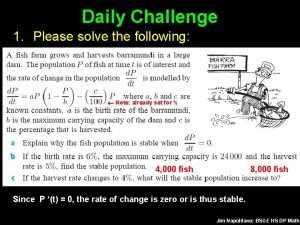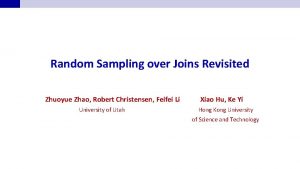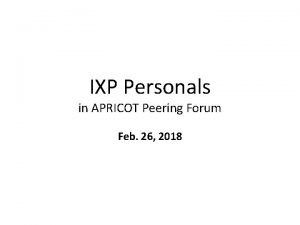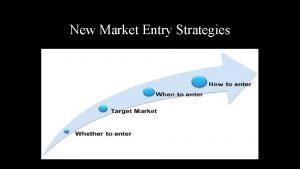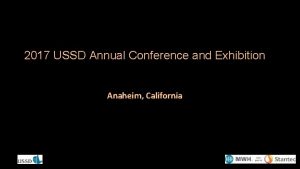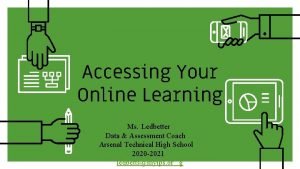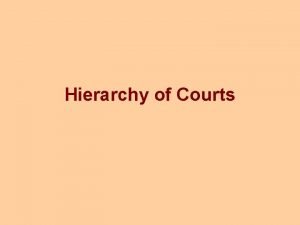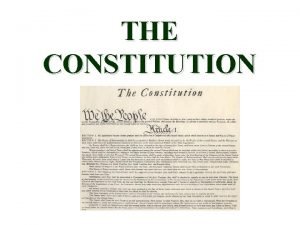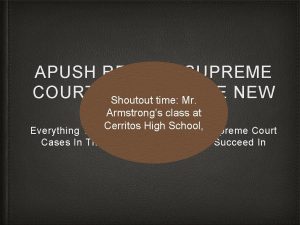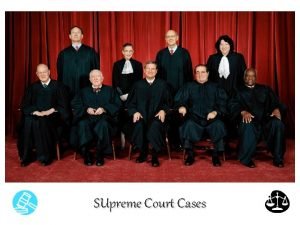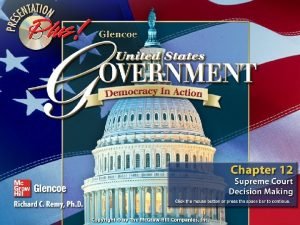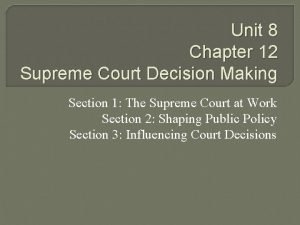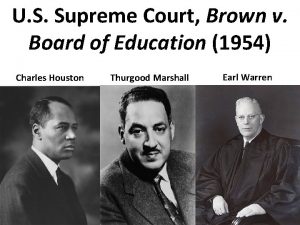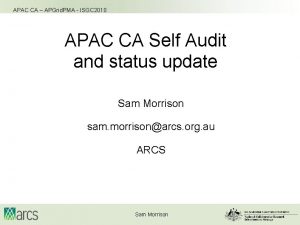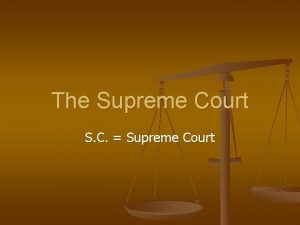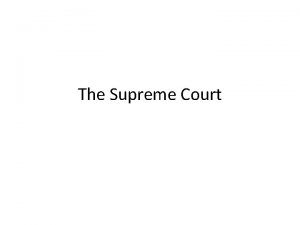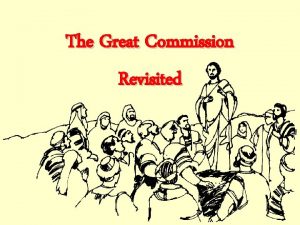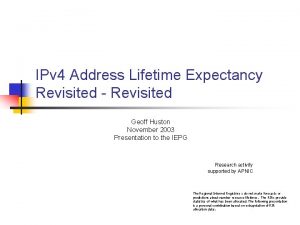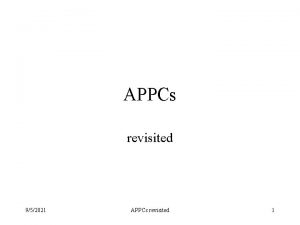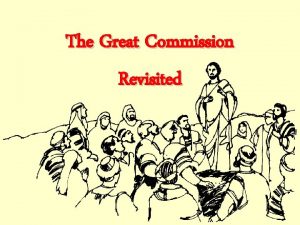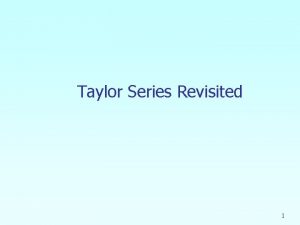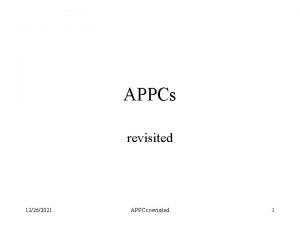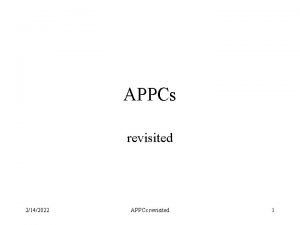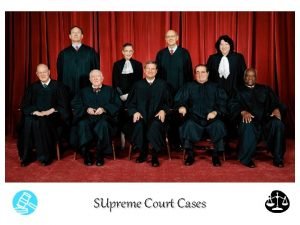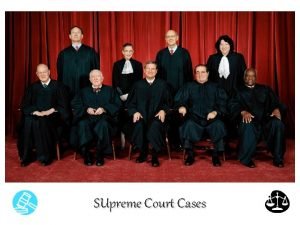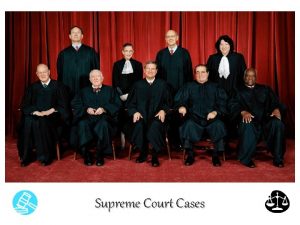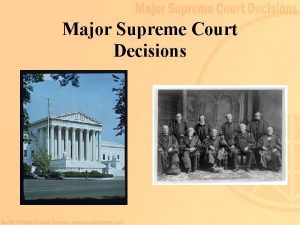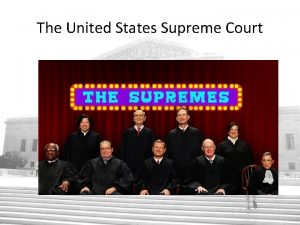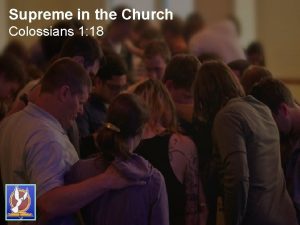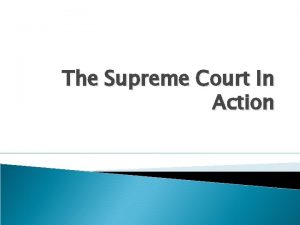APAC 2016 Anaheim The Supremes Revisited Recent Supreme





































- Slides: 37

APAC 2016 Anaheim The Supremes Revisited: Recent Supreme Court Decisions Benwari Singh

Introductions Benwari Singh • 24 years as an educator • Cherry Creek High School in Colorado • Current Co-Chair of the AP U. S. Government Test Development Committee • Reader/Table Leader at the AP U. S. Government reading for the past thirteen years The Supremes Revisited: Recent Supreme Court Decisions 2

Purpose of Today’s Presentation 1. ) Share a nonideological definition of judicial activism that can be applied to Supreme Court decisions. 2. ) Share a framework that can be used by students to analyze Supreme Court decisions. 3. ) Apply the framework to several recent Supreme Court decisions regarding civil rights in modern America. 4. ) Present a classroom strategy that will allow students to use Supreme Court decisions to practice critical thinking skills. The Supremes Revisited: Recent Supreme Court Decisions 3

Goal One: Define Judicial Activism • The least developed branch of government, at least from a Constitutional perspective, is the judicial branch. • Much of the early thinking regarding the role of the Supreme Court was influenced by Federalist #78, which argued that: • the Court would have the power of judicial review. • the Court would be “the least dangerous” branch. • “It has neither Force nor Will, but merely judgment. ” The Supremes Revisited: Recent Supreme Court Decisions 4

Goal One: Define Judicial Activism http: //freedom-school. com/law/federalist-papers-in-modern-language. pdf The Supremes Revisited: Recent Supreme Court Decisions 5

Goal One: Define Judicial Activism • Many argue that the SCOTUS may be the most powerful branch today, especially in a polarized government. • This has led to many complaints about an overbearing court. • Often these complaints are tied to the accusation of judicial activism. The Supremes Revisited: Recent Supreme Court Decisions 6

Goal One: Define Judicial Activism • The problem with accusations of judicial activism is that both sides of the ideological spectrum use the term to disparage decisions they do not agree with. • Students need a non-ideological definition of judicial activism, because there is conservative and liberal activism. • Judicial activism is a decision in which the Court strikes down a legislative act or creates a new right. • Judicial restraint is when the Court defers to elected bodies or rarely overturns precedent. • Chief Justice Roberts said during his confirmation hearing, “My job is to call balls and strikes and not to pitch or bat. ” The Supremes Revisited: Recent Supreme Court Decisions 7

Goal Two: Share a framework for analyzing Supreme Court decisions The Supremes Revisited: Recent Supreme Court Decisions

Goal Two: Share a framework for analyzing Supreme Court decisions Students use the following steps to break down and analyze any Supreme Court decision: Facts of the Case Describe what happened. Why is there a court case? Who? What? When? Where? Issue Identify the question(s) the Supreme Court is being asked to answer in this particular case. The issue should be framed in the form of a question and always have a link to the Constitution. The Supremes Revisited: Recent Supreme Court Decisions 9

Goal Two: Share a framework for analyzing Supreme Court decisions Decision State the answer the Court gave to the question(s) previously identified as the Issue. Students should give the vote breakdown. Rationale Explain why the Court made the decision that they did. Describe the reasoning used by the Justices. Impact Explain how the decision in the particular case being examined changed the United States. How are rights/liberties different because of this decision? How did the public react? Was the decision popular? With whom? Was the decision an example of activism or restraint? The Supremes Revisited: Recent Supreme Court Decisions 10

Goal Three: Practice the framework The Supremes Revisited: Recent Supreme Court Decisions

Goal Three: Practice the framework Shelby County v. Holder (2013) Facts The Voting Rights Act of 1965 (VRA) used several methods to improve voter registration and voter turnout among minorities, primarily African. Americans: • Section 5 of the VRA created preclearance. • Section 4 of the VRA created the formula used to determine which states would be required to comply with Section 5. Ø States or local governments that used a “test or device” to restrict voting. Ø States or local governments in which fewer than 50% of eligible citizens were registered to vote OR had voted in the presidential election. The Supremes Revisited: Recent Supreme Court Decisions 12

Goal Three: Practice the framework Shelby County v. Holder (2013) Facts • These requirements were originally set to expire after five years, but Congress renewed them several times. The last was in 2006 – for 25 more years. • Shelby County (Alabama) filed suit in 2010 seeking to have Sections 4 and 5 of the VRA declared unconstitutional. The Supremes Revisited: Recent Supreme Court Decisions 13

Goal Three: Practice the framework Shelby County v. Holder (2013) Issue Decision • Do Sections 4 and 5 of the Voting Rights Act violate the 10 th Amendment, more specifically the traditions of equal sovereignty? The Supremes Revisited: Recent Supreme Court Decisions • In a 5 -4 decision, the Court held that Section 4 of the VRA is unconstitutional, but left Section 5 of the VRA in place. 14

Goal Three: Practice the framework Shelby County v. Holder (2013) Rationale • The Framers rejected a proposal to allow the national government to reject state laws before enactment. • The Court had previously created the doctrine of equal sovereignty, which Section 4 violated. • The VRA had, in most part, accomplished its goal. Voter registration and turnout in preclearance jurisdictions was close to parity, even surpassing white voter turnout in 2008 in five of the six original preclearance states. • The court argued Congress could update the formula, but… The Supremes Revisited: Recent Supreme Court Decisions 15

Goal Three: Practice the framework Shelby County v. Holder (2013) Impact • In the aftermath of the Shelby County decision, a number of states have passed voter ID laws that critics argue are designed to limit voter participation by racial minorities, the poor, and other groups in the United States. • Activism or Restraint? The Supremes Revisited: Recent Supreme Court Decisions 16

Goal Three: Practice the framework Obergefell v. Hodges (2015) Practice the framework! Using your phone, tablet, or laptop, go to http: //apac 2013. weebly. com/apac-2016 to find a pdf of the Obergefell decision. The Supremes Revisited: Recent Supreme Court Decisions 17

Goal Three: Practice the framework Obergefell v. Hodges (2015) Facts • James Obergefell and John Arthur, both of whom lived in Ohio (which outlawed SSM), had been in a committed relationship for over twenty years. • In 2011, Arthur was diagnosed with ALS, Lou Gehrig’s disease. • In 2013, Obergefell and Arthur flew to Maryland in order to be married. • Three months after their marriage, Arthur died. • Ohio law did not recognize their marriage, and therefore Obergefell could not be listed as the surviving spouse on Arthur’s death certificate. The Supremes Revisited: Recent Supreme Court Decisions 18

Goal Three: Practice the framework Obergefell v. Hodges (2015) Issue • Do state laws outlawing same-sex marriage, or the recognition of same sex marriages performed in other states, violate the Due Process and Equal Protection clauses of the Fourteenth Amendment? The Supremes Revisited: Recent Supreme Court Decisions 19

Goal Three: Practice the framework Obergefell v. Hodges (2015) Decision • In a 5 -4 decision, the Court ruled that state laws that deny same-sex marriage or the recognition of samesex marriages performed in other states violate both the Due Process and Equal Protection clauses of the Fourteenth Amendment. The Supremes Revisited: Recent Supreme Court Decisions 20

Goal Three: Practice the framework Obergefell v. Hodges (2015) Rationale • The Court had previously ruled that the right to marry is a “fundamental” right protected by the Due Process clause in a variety of situations. • Because marriage serves four “principles” in society, it was no longer acceptable to deny the right to marry to same sex couples: Ø An expression of “individual autonomy” Ø Supports a “two person union” Ø Protects children and the family – not tied to procreation Ø Foundation of social order The Supremes Revisited: Recent Supreme Court Decisions 21

Goal Three: Practice the framework Obergefell v. Hodges (2015) Rationale • The Court also ruled that same-sex marriage bans violate the Equal Protection Clause, in part because “the Court has recognized that new insights and societal understandings can reveal unjustified inequality…” The Supremes Revisited: Recent Supreme Court Decisions 22

Goal Three: Practice the framework Obergefell v. Hodges (2015) Impact • The Obergefell decision legalized same-sex marriage throughout the United States. • However, some states have passed religious liberty laws that allow businesses and other groups to deny services to homosexuals on the basis of their religious beliefs. Ø “Bathroom” Wars • Activism or Restraint? The Supremes Revisited: Recent Supreme Court Decisions 23

Goal Three: Practice the framework Fisher v. University of Texas (2016) Facts • Texas uses the “Ten Percent” rule for admission to state universities. • Abigail Fisher was not in the top ten percent of her high school’s graduating class, so she had to apply to UT outside of the Ten Percent rule in 2008. • Fisher was not accepted and subsequently filed a lawsuit arguing that the University’s consideration of race in the admissions process was a violation of the Fourteenth Amendment’s Equal Protection Clause. The Supremes Revisited: Recent Supreme Court Decisions 24

Goal Three: Practice the framework Fisher v. University of Texas (2016) Decision Issue • Does the University of Texas’s • In a 4 -3 decision, the Court ruled that UT’s use of race consideration of race in the admissions process violate the did not violate the Equal Protection Clause of the Fourteenth Amendment? Fourteenth Amendment. The Supremes Revisited: Recent Supreme Court Decisions 25

Goal Three: Practice the framework Fisher v. University of Texas (2016) Rationale • The Court argued that previous rulings, especially Grutter and an earlier Fisher case, created three “controlling principles” regarding the use of affirmative action in college admissions: Ø The use of race in admissions must withstand “strict scrutiny” – the use is both constitutional and necessary. Ø The use of race in admissions serves a significant academic purpose. Ø The use of race neutral methods had failed to meet the significant academic purpose set forth by an institution. The Supremes Revisited: Recent Supreme Court Decisions 26

Goal Three: Practice the framework Fisher v. University of Texas (2016) Rationale • The Court argued that the policy used by the University of Texas met each of the principles that the Court had set out in previous decisions and therefore the use of race in the admissions process was not a violation of the Equal Protection Clause. • Activism or Restraint? The Supremes Revisited: Recent Supreme Court Decisions 27

Goal Four: Classroom Strategies to Promote Critical Thinking The Supremes Revisited: Recent Supreme Court Decisions

Goal Four: Classroom Strategies to Promote Critical Thinking Key Supreme Court Cases Tournament Bracket Project Objective: Students will individually research a key Supreme Court case. Then, working in groups, students will organize the cases in a tournament playoff bracket and decide on an overall winner. The Supremes Revisited: Recent Supreme Court Decisions 29

Goal Four: Classroom Strategies to Promote Critical Thinking Part I: Researching a Key Supreme Court Case • • • • U. S. v. Reynolds (1879) Brown v. Board of Education of Topeka (1954) Mapp v. Ohio (1961) Engel v. Vitale (1962) Gideon v. Wainwright (1963) Miranda v. Arizona (1966) Brandenburg v. Ohio (1969) Tinker v. Des Moines (1969) Lemon v. Kurtzman (1971) New Jersey v. T. L. O. (1985) Bethel School District No. 403 v. Fraser (1986) Texas v. Johnson ((1989) Planned Parenthood v. Casey (1992) Church of Lukumi Babalu Aye, Inc. v. City of Hialeah (1993) Obergefell v. Hodges (2015) Fisher v. University of Texas (2016) The Supremes Revisited: Recent Supreme Court Decisions 30

Goal Four: Classroom Strategies to Promote Critical Thinking Part I: Researching a Key Supreme Court Case For each assigned case, a “one-pager” will be completed that includes the following information about the Supreme Court case: • Facts: Students should describe what happened. Why is there a court case? Who? What? When? Where? • Issue: Students should identify the question the Supreme Court is being asked to answer in this particular case. The issue should always be framed in the form of a question and have a link to the Constitution. • Decision: Students should be able to identify the answer the Court gave to the question they identified as the Issue. Students should give the vote breakdown, as well. • Rationale: Students should explain why the Court made the decision that they did. Students should describe the reasoning used by the justices (all significant opinions). The Supremes Revisited: Recent Supreme Court Decisions 31

Goal Four: Classroom Strategies to Promote Critical Thinking Part I: Researching a Key Supreme Court Case For each assigned case, a SECOND “one-pager” will be completed that includes the following information about the Supreme Court case: • Related cases/precedents. • An explanation of whether the decision is an example of Judicial Activism or Judicial Restraint and an explanation of why. • Challenges - The SCOTUS lacks enforcement. Students should be able to explain how the decision is/was enforced. Are there legislative or other litigation based challenges? • A visual representation – photo/image. The Supremes Revisited: Recent Supreme Court Decisions 32

Goal Four: Classroom Strategies to Promote Critical Thinking Part II: Creating the Brackets • Students will receive a packet of the sixteen key Supreme Court cases. Exemplary examples will be chosen from among all classes. • Working in groups of four, students will put the cases into a tournament bracket using either the bracket provided or one printed from an online template. (http: //www. freebracketgenerator. com/) • When creating the tournament bracket, students need to consider the following: • Which cases will fall into each quadrant – look for similarities and differences when deciding on the groupings of four. • Once the four groupings are created, the cases will then need to be appropriately placed into pairs. The Supremes Revisited: Recent Supreme Court Decisions 33

Goal Four: Classroom Strategies to Promote Critical Thinking Part II: Creating the Brackets – Court Case Brackets 1 st Amendment – Freedom of Religion – Free Practice and Establishment • U. S. v. Reynolds (1879) • Church of Lukumi Babalu Aye, Inc. v. City of Hialeah (1993) • Lemon v. Kurtzman (1971) • Lee v. Weisman (1972) 1 st Amendment – Free Speech (Spoken and Symbolic) • Brandenburg v. Ohio (1969) • Tinker v. Des Moines (1969) • Bethel School District No. 403 v. Fraser (1986) • Texas v. Johnson (1989) The Supremes Revisited: Recent Supreme Court Decisions 34

Goal Four: Classroom Strategies to Promote Critical Thinking Part II: Creating the Brackets – Court Case Brackets 4 th and 5 th/6 th Amendments – Criminal Due Process • Mapp v. Ohio (1961) • New Jersey v. T. L. O. (1985) • Gideon v. Wainwright (1963) • Miranda v. Arizona (1966) 14 th Amendment – Equal Protection and Due Process • Brown v. Board of Education of Topeka (1954) • Planned Parenthood v. Casey (1992) • Obergefell v. Hodges (2015) • Fisher v. University of Texas (2016) The Supremes Revisited: Recent Supreme Court Decisions 35

Goal Four: Classroom Strategies to Promote Critical Thinking Part III: Playing the Bracket • Working in the same groups, students will play the “teams” (the cases) against one another on the tournament bracket. • The winner of each “game” will be based upon which case they believe has had the most significant influence on the U. S. • Students will write a short justification about the loser of each bracket, explaining why they felt that particular case was less significant than the winner. • For the Championship Game, students will need to explain in detail why those two cases reached the final and why the overall winner eventually won. The Supremes Revisited: Recent Supreme Court Decisions 36

Thank you for coming to my session. If you have any questions do not hesitate contact me. My email is: bsingh 4@cherrycreekschools. org Documents are available at: http: //apac 2013. weebly. com/apac-2016 The Supremes Revisited: Recent Supreme Court Decisions 37
 Math lesson
Math lesson Zhuoyue zhao
Zhuoyue zhao Personalsin xxx
Personalsin xxx Steelcase apac
Steelcase apac Gotowebnar
Gotowebnar Ussd
Ussd 700 w convention way anaheim ca 92802
700 w convention way anaheim ca 92802 Emerging trends in mis
Emerging trends in mis Trends in project portfolio management
Trends in project portfolio management Biotaphonomy
Biotaphonomy News passive voice
News passive voice Is college worth it synthesis essay
Is college worth it synthesis essay Https drive google com drive u 0 recent
Https drive google com drive u 0 recent Recent demographic changes in the uk
Recent demographic changes in the uk After a skydiving accident laurie
After a skydiving accident laurie Recent trends in ic engine
Recent trends in ic engine Https://drive.google.com/drive/
Https://drive.google.com/drive/ Trends in india foreign trade
Trends in india foreign trade A friend emails you the results of a recent high school
A friend emails you the results of a recent high school Recent developments in ict
Recent developments in ict Udin login
Udin login Scanning reading benefits
Scanning reading benefits Myips.schoology.com
Myips.schoology.com Recent advances in ceramics
Recent advances in ceramics Recent developments in object detection
Recent developments in object detection Quelle est cette montagne
Quelle est cette montagne Victorian court hierarchy
Victorian court hierarchy Supreme court
Supreme court Jurisdiction of supreme court
Jurisdiction of supreme court Supreme law of the land clipart
Supreme law of the land clipart Supreme marketing mix
Supreme marketing mix Supreme ordeal definition
Supreme ordeal definition Important court cases apush
Important court cases apush Insular cases apush
Insular cases apush Supreme court does
Supreme court does Vocabulary activity 12 supreme court decision making
Vocabulary activity 12 supreme court decision making John marshall supreme court
John marshall supreme court Supreme court
Supreme court
